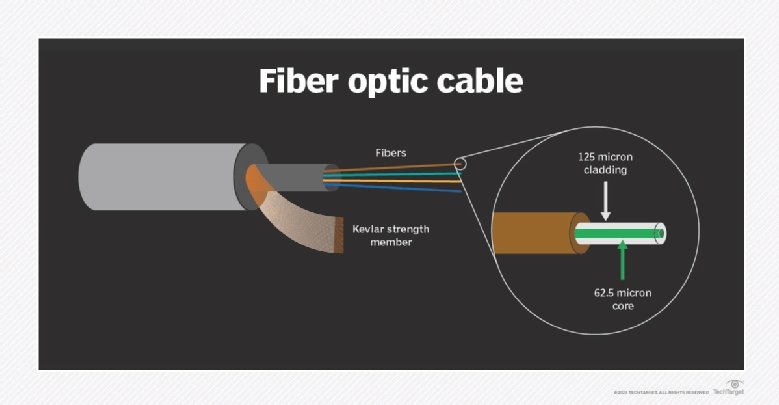Fiber Optics
Fiber optics, or optical fiber, refers to the medium and the technology associated with the transmission of information as light pulses along a glass or plastic strand or fiber. A fiber optic cable can contain a varying number of these glass fibers — from a few up to a couple hundred. Surrounding the glass fiber core is another glass layer called cladding. A layer known as a buffer tube protects the cladding, and a jacket layer acts as the final protective layer for the individual strand.
How fiber optics works
Fiber optics transmit data in the form of light particles — or photons — that pulse through a fiber optic cable. The glass fiber core and the cladding each have a different refractive index that bends incoming light at a certain angle. When light signals are sent through the fiber optic cable, they reflect off the core and cladding in a series of zig-zag bounces, adhering to a process called total internal reflection. The light signals do not travel at the speed of light because of the denser glass layers, instead traveling about 30% slower than the speed of light. To renew, or boost, the signal throughout its journey, fiber optics transmission sometimes requires repeaters at distant intervals to regenerate the optical signal by converting it to an electrical signal, processing that electrical signal and retransmitting the optical signal.
Types of fiber optic cables
Multimode fiber and single-mode fiber are the two primary types of fiber optic cable. Single-mode fiber is used for longer distances due to the smaller diameter of the glass fiber core, which lessens the possibility for attenuation — the reduction in signal strength. The smaller opening isolates the light into a single beam, which offers a more direct route and allows the signal to travel a longer distance. Single-mode fiber also has a considerably higher bandwidth than multimode fiber. The light source used for single-mode fiber is typically a laser. Single-mode fiber is usually more expensive because it requires precise calculations to produce the laser light in a smaller opening.

Fiber optics uses
Computer networking is a common fiber optics use case, due to optical fiber’s ability to transmit data and provide high bandwidth. Similarly, fiber optics is frequently used in broadcasting and electronics to provide better connections and performance.
Military and space industries also make use of optical fiber as means of communication and signal transfer, in addition to its ability to provide temperature sensing. Fiber optic cables can be beneficial due to their lighter weight and smaller size.
Fiber optics is frequently used in a variety of medical instruments to provide precise illumination. It also increasingly enables biomedical sensors that aid in minimally invasive medical procedures. Because optical fiber is not subject to electromagnetic interference, it is ideal for various tests like MRI scans. Other medical applications for fiber optics include X-ray imaging, endoscopy, light therapy and surgical microscopy.